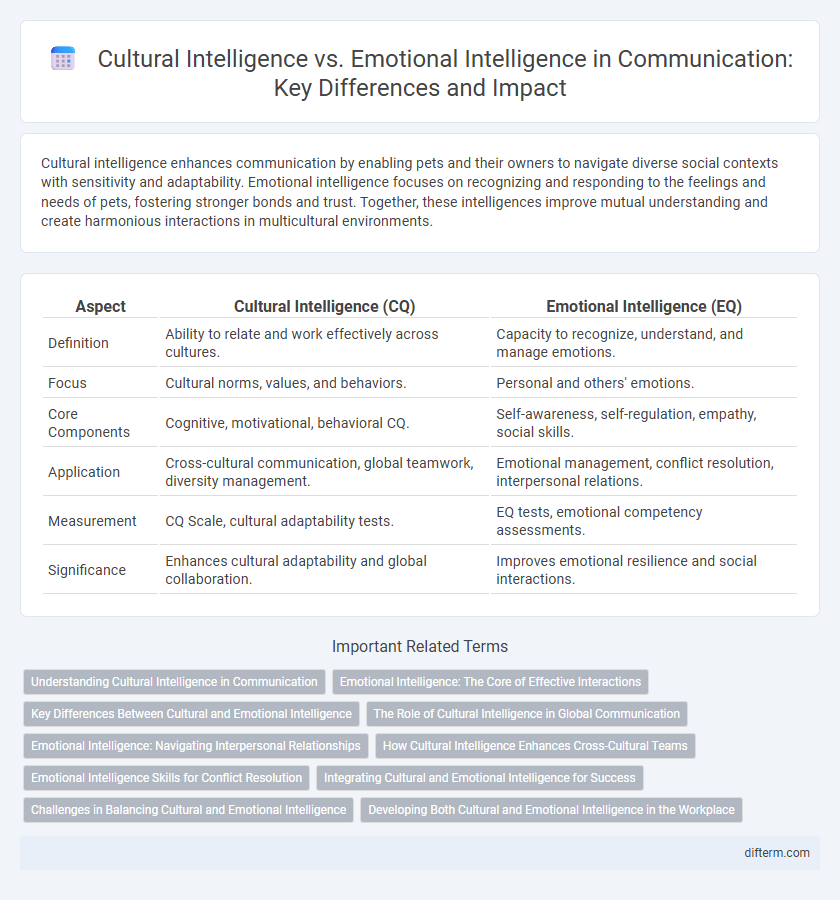Cultural intelligence enhances communication by enabling pets and their owners to navigate diverse social contexts with sensitivity and adaptability. Emotional intelligence focuses on recognizing and responding to the feelings and needs of pets, fostering stronger bonds and trust. Together, these intelligences improve mutual understanding and create harmonious interactions in multicultural environments.
Table of Comparison
| Aspect | Cultural Intelligence (CQ) | Emotional Intelligence (EQ) |
|---|---|---|
| Definition | Ability to relate and work effectively across cultures. | Capacity to recognize, understand, and manage emotions. |
| Focus | Cultural norms, values, and behaviors. | Personal and others' emotions. |
| Core Components | Cognitive, motivational, behavioral CQ. | Self-awareness, self-regulation, empathy, social skills. |
| Application | Cross-cultural communication, global teamwork, diversity management. | Emotional management, conflict resolution, interpersonal relations. |
| Measurement | CQ Scale, cultural adaptability tests. | EQ tests, emotional competency assessments. |
| Significance | Enhances cultural adaptability and global collaboration. | Improves emotional resilience and social interactions. |
Understanding Cultural Intelligence in Communication
Cultural intelligence in communication involves recognizing and adapting to diverse cultural norms, values, and communication styles to enhance interpersonal effectiveness. It requires skills in cultural awareness, empathy, and cognitive flexibility to interpret messages accurately across cultural contexts. Unlike emotional intelligence, which focuses on managing personal and others' emotions, cultural intelligence prioritizes navigating cultural differences to reduce misunderstandings and foster inclusive dialogue.
Emotional Intelligence: The Core of Effective Interactions
Emotional intelligence is the foundational skill for effective communication, enabling individuals to recognize, understand, and manage their own emotions while empathizing with others. High emotional intelligence fosters trust, reduces conflicts, and enhances collaboration by promoting active listening and responsive feedback. This core competency surpasses cultural intelligence in personal interactions, as it directly influences emotional connections and adaptive communication strategies across diverse settings.
Key Differences Between Cultural and Emotional Intelligence
Cultural intelligence measures the ability to understand and adapt to diverse cultural contexts, emphasizing awareness of cultural norms, values, and behaviors. Emotional intelligence involves recognizing, understanding, and managing one's own emotions and those of others to build effective interpersonal relationships. The key difference lies in cultural intelligence focusing on external cultural environment adaptation, while emotional intelligence centers on internal emotional regulation and social interaction skills.
The Role of Cultural Intelligence in Global Communication
Cultural intelligence plays a crucial role in global communication by enabling individuals to effectively interpret and respond to diverse cultural cues, minimizing misunderstandings in multinational interactions. Unlike emotional intelligence, which centers on recognizing and managing personal emotions, cultural intelligence emphasizes adaptability and awareness of cultural norms, values, and practices across different societies. High cultural intelligence fosters better collaboration, negotiation, and relationship-building in international business and diplomatic contexts, driving successful cross-cultural exchanges.
Emotional Intelligence: Navigating Interpersonal Relationships
Emotional intelligence plays a crucial role in effectively navigating interpersonal relationships by enabling individuals to recognize, understand, and manage both their own emotions and those of others. Key components such as empathy, self-regulation, and social skills facilitate harmonious communication and conflict resolution across diverse social settings. Developing emotional intelligence enhances collaboration, fosters trust, and improves overall relational dynamics in personal and professional environments.
How Cultural Intelligence Enhances Cross-Cultural Teams
Cultural intelligence enables cross-cultural teams to navigate diverse social norms and communication styles, fostering greater collaboration and reducing misunderstandings. Teams with high cultural intelligence demonstrate enhanced adaptability and empathy towards cultural differences, resulting in improved problem-solving and innovation. This competency supports effective leadership and teamwork by bridging cultural gaps that emotional intelligence alone may not address.
Emotional Intelligence Skills for Conflict Resolution
Emotional intelligence skills such as self-awareness, empathy, and emotional regulation are crucial for effective conflict resolution, enabling individuals to navigate interpersonal tensions with sensitivity and understanding. These skills enhance active listening and facilitate constructive dialogue, reducing misunderstandings and fostering mutual respect in diverse communication settings. Developing emotional intelligence promotes collaborative problem-solving and helps maintain positive relationships in both personal and professional environments.
Integrating Cultural and Emotional Intelligence for Success
Integrating cultural intelligence (CQ) and emotional intelligence (EQ) enhances communication effectiveness in diverse environments by fostering empathy and adaptability. Cultural intelligence allows individuals to decode cultural cues and navigate varying social norms, while emotional intelligence strengthens interpersonal relationships through self-awareness and emotional regulation. Combining CQ and EQ equips leaders and teams to build trust, resolve conflicts, and collaborate seamlessly across global contexts.
Challenges in Balancing Cultural and Emotional Intelligence
Balancing cultural intelligence and emotional intelligence presents challenges such as navigating diverse communication styles and managing emotional responses across different cultural norms. Misinterpretations often arise when emotional cues are expressed differently across cultures, complicating effective interpersonal interactions. Developing both intelligences requires continuous learning and adaptation to foster inclusive and empathetic communication in global contexts.
Developing Both Cultural and Emotional Intelligence in the Workplace
Developing both cultural and emotional intelligence in the workplace enhances communication effectiveness by enabling employees to navigate diverse cultural norms and manage emotions constructively. Cultural intelligence improves adaptability in multicultural settings, while emotional intelligence fosters empathy and conflict resolution. Integrating these skills leads to a more inclusive, collaborative, and productive work environment.
cultural intelligence vs emotional intelligence Infographic

 difterm.com
difterm.com